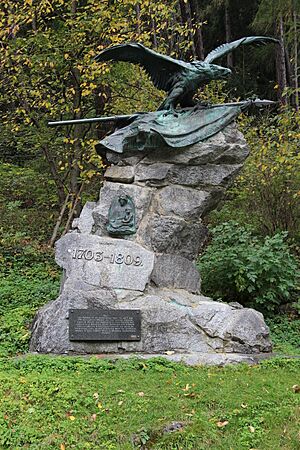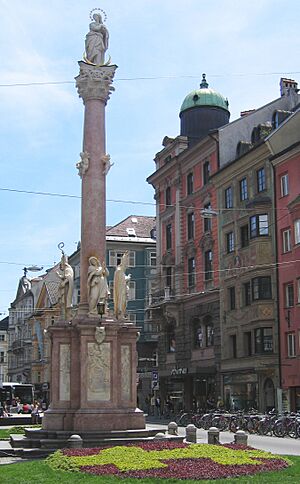Bavarian Rummel facts for kids
The Bavarian Rummel was a special name given to a short war that happened in 1703. The word Rummel means 'hustle and bustle' or 'commotion'. This name was used to make the serious events seem less important. During this time, soldiers from Bavaria, led by their ruler Maximilian II Emanuel of Bavaria, invaded a region called County of Tyrol. This all took place during a much bigger conflict known as the War of the Spanish Succession.
What Happened During the Bavarian Rummel?
On June 19, 1703, Bavarian soldiers started to attack the town of Kufstein. Fires broke out around the town. These fires quickly spread and destroyed much of Kufstein. The flames even reached the gunpowder storage of the fortress, which was thought to be very strong. The huge amount of gunpowder exploded, and Kufstein had to surrender on June 20.
On the same day, the people of Tyrol in Wörgl also gave up. Two days later, Rattenberg was captured. On June 25, the city of Innsbruck was taken without a fight.
However, the Bavarians soon faced difficulties. On July 1, the Tyrolese fought back strongly. They had victories against the Bavarian troops at the Pontlatzer Bridge in the upper Inn Valley, at the Brenner Pass, and near Innsbruck.
By July 26, which is Saint Anne's Day, Tyrol was free again! Maximilian Emanuel and his troops had to retreat back to Bavaria through Seefeld in Tirol.
Years later, in 2011, during building work in Pfons in the Wipptal valley, some graves were found. People believe these might be the graves of Bavarian soldiers. They were not buried in a regular cemetery but in groups of three near the river. This idea comes from old clues mentioned in the local history books of Matrei am Brenner.
How Tyrol Remembers the Events
To show their thanks for gaining freedom, the people of Tyrol decided in 1704 to build a special monument. This monument was the St. Anne's Column, which was put up in Innsbruck in 1706.
The Bavarian Rummel, along with another fight for Tyrolean freedom in 1809, is a very important part of Tyrol's history. It helped create the strong image of the "fighting Tyrolean farmer," showing how determined the people of Tyrol were to protect their home.



